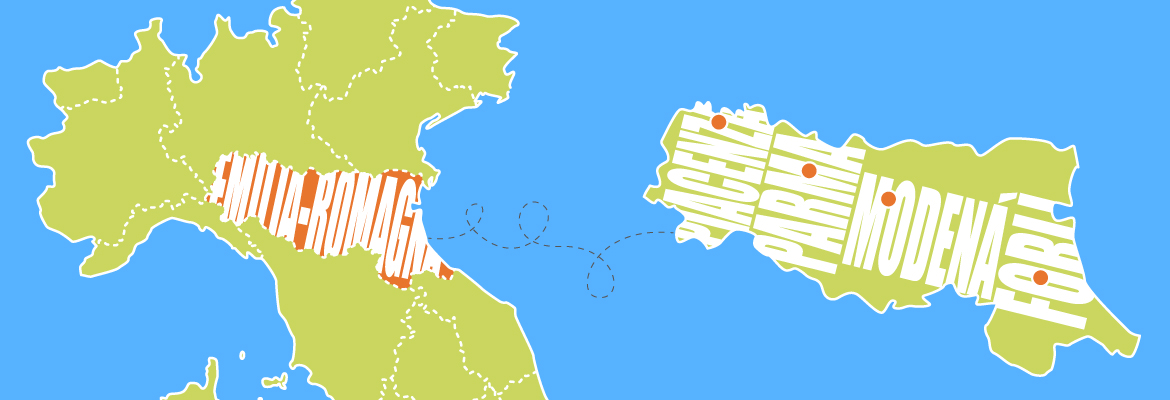Emilia-Romagna is the first Italian region to have taken on, by law, the circular economy as the North Star of its waste policy with the aim of reducing mixed MSW production and recover as much matter as possible for recycling.
It did so through the eleven articles of Law 16 that came into force on October 5th 2015. Its title acts as a brief programmatic manifesto: “Rules and regulations supporting the circular economy, the reduction of municipal solid waste, the reuse of end-of-life goods, separate waste collection and amendments to the regional law n. 31 of 19th August 1996 (Protocol of special tax regulations for municipal solid waste management in landfills).”
In order to implement this “philosophical” breakthrough, the law introduced a permanent Forum on the circular economy, where local institutions, civil society’s representatives, economic organizations representing businesses and environmental associations will participate. As to MSW management, the law allocated single municipalities rather ambitious minimum targets to be achieved by 2020. Indeed, compared to the 2011 municipal solid waste production, the target is now to reduce it by 20-25%, in order to achieve an average of 150 kilograms per year per citizen by 2020. While, for separate waste collection, the bar is raised to 73%, of which at least 70% to be sent for actual recycling.
So, these are the numbers. With an observation, before examining the articles in detail: the approved text is the result of two bills by people’s initiative and an intense participatory activity involving municipalities and environmental associations since the last administrative mandate. “Such aspect needs highlighting because it shaped the content of the law and its involvement with local situations” admits the Democratic Party regional councillor Lia Montalti, spokesperson for this law at the Committee for the Environment. Before being submitted to the regional Assembly, the two bills by people’s initiative – drawn up by Natale Belosi, an expert at Ecoistituto in Faenza – had been passed by the city councils of 60 large and small municipalities (including Forlì, Modena, Parma and Piacenza) and by the Reggio Emilia Province. An “institutional critical mass” which represented 60% of Emilia-Romagna population which, together with Legambiente, WWF and various local committees and eight past legislature’s regional majority councillors, put pressure on the Region in order for it to pass such initiative. So, within a few months, the text for Law 16 was defined, which, Belosi admits, to a certain extent, it integrates and improves on the proposals passed by the municipalities, 50% of which have been accepted.
The objective to minimize mixed waste production, overriding energy recovery in incineration plants, is the real “Copernican revolution” in the MSW management. Basically, subverting the criterion adopted so far, the benchmark against which measuring the effectiveness of waste management municipal policies is no longer the amount of separate collection obtained – which as Belosi claims can be rigged by including huge quantities of inert waste from demolition – but rather a drop in the mixed waste fraction not sent for recycling.
In order to allow the municipalities to achieve the targets by 2020, Law 16 created three instruments aimed at rewarding local administrations and citizens achieving the best results in reducing mixed waste production. Vice versa, it penalizes the most prodigal.
The first of such instruments is the Fund to promote waste prevention and reduction. Half of it is aimed at reducing the costs of MSW management for citizens-users in the municipalities achieving a high level of reduction of mixed waste (to be precise, the share produced for inhabitant equivalent – including city users and tourists – must be lower than 70% of the regional average). While the remaining 50% of the Fund is meant to finance, in the form of automatic and progressive incentives, projects and investments by the municipalities devoted to increasing separate waste collection, and waste production reduction. They are also aimed at the creation of municipal centre for reuse, where goods brought by citizens will undergo appropriate maintenance so that they may be used again. So, the most virtuous local administrations will be allocated more resources and local citizens will lower their bills. The Fund’s allocation scheme will remain in place up until 2020, while later on two thirds will be used to reduce bills and one third to fund projects for the municipalities.
The second instrument is the Special Tax for MSW landfilling, as well as the disposal of waste in its unaltered state into incineration plants without energy recovery: such tax is added to the pre-existing Ecotax on waste management as provided by the 1996 law. The rationale behind such increment is easily understood. It is an attempt to make waste disposal economically unpalatable, thus paving the way for the dismantling of operating landfills in Emilia-Romagna. In this respect, the municipalities producing more mixed waste will be penalized, so they will have to pay a higher Ecotax to the Region.
The third innovative instrument – quantity-based tariff – introduces another fairness criterion: citizens will pay their waste tax according to landfilled mixed waste fraction. Gone are the days of calculation systems based on the size of the house or the number of family members. In this way the regulatory gap that up until now prevented municipalities from adopting such tariff method is filled. Such measure, “based on existing experiences, proved to contribute to the reduction of waste production in an effective way” Montalti commented. “Now, the law requires all municipalities to adopt it by 2020. Moreover quantity-based tariff will allow businesses to claim VAT on paid services.” With the ordinary waste tax, such opportunity did not exist.
Regional policies introduced within a circular economy include the stated commitment to promote the development of plant design linked to reusing and recycling of both mixed and separate fractions. And also “the support to research of residual waste in order to modify the upstream production of currently non recyclable goods, thus promoting matter recovery,” highlights Michele Giovannini, mayor of Castello d’Argile (Bologna), who led the group of colleagues in their negotiations with the Region. Moreover, to maximise the reduction of organic waste production and the environmental impacts deriving from their management, domestic and community composting is encouraged, starting from users living in rural areas and in isolated properties.
The financing of the incentive Fund is also in line with fair criteria, since “those municipalities producing more mixed waste will have to pay more” Montalti points out. Indeed, the Fund (article 3) will be partly financed with a percentage between 5 to 15% of the overall cost of mixed waste management paid by the municipalities (such cost is explained in the town economic-financial plans and is covered by the bills paid by users); partly (article 7) with a percentage of the above-mentioned Ecotax collected by the Region. It is not specified in the law and it will be decided on a yearly basis by the town council. Since the approved text does not specify the overall maximum amount of financing of the Fund, during a debate occurred in the Assembly, the town council has been entrusted by law to guarantee with its resources the minimum amount of €10 million a year.
With regard to the fractions of separate waste collection, Law 16 has no restrictions: “Considering local experiences, the law encompasses both door to door and equivalent systems in terms of results, in order to avoid interfering inappropriately with the autonomy of municipalities” as explained by Montalti. Fines issued by the government on separate waste collection’s yields as of 31st December 2020 will be calculated on the basis of ISPRA (Institute for Environmental Protection and Research).
An interesting aspect of the law is the less stringent attitude towards those people allocated a particular environmental service. Indeed, according to article 6 “the manager of the collection service does not have to coincide with that overseeing waste management plants,” thus eliminating the temptation by single managers to choose collection modalities according to the use of their incineration plants and landfills, rather than matter recovery.
Other innovations include the environmental inspectors to fight “wild waste”: managers of MSW collection services also act as ascertaining agents: they will be able to dispute users’ behaviour contravening collection modalities as envisaged by municipalities.
As for businesses, those innovating in the production and product cycles aimed at reducing production waste, the law (article 2, paragraph 3) refers to incentives provided for in other regional regulations, for example the allocation of European funds. Moreover (paragraph 3), requires that waste management service can include incentives for those businesses operating towards the prevention of waste production. This also includes both charity and social activities and initiatives that have already obtained formal certification of their shops from an environmental and energy point of view according to protocols agreed with the Region (the first was signed in November with Legacoop and other Emilia Romagna large-scale retail trade). Here too, a large regulatory gap that in the past prevented municipalities to reward local businesses reducing waste production and good and matter recovery has been filled.
Now that the law has been approved, the next legislative step the Regional Council and the legislative Assembly have to face will be to include in the regional waste Plan, currently being discussed, the new targets for mixed, separate collections and recycling, with special reference to the revision of plant design programming envisaged in the current plan approved in 2011.
“With regard to the timings proposed by the new waste Plan, the political will to approve first and foremost Law 16 has prevailed. Such law promotes the reduction of mixed waste production and encourages recycling and separate waste collection” Montalti highlights.
“The adoption of the new Plan will require strong commitment because according to the current one, of the 30 open landfills, only 4 will stay operational, and such number will have to be consistent with the objectives of Law 16. Something is being done with incinerators as well: the regional government is organizing local meetings in order to shut down a few, revising the previous plan, as it is now only natural, in the light of the new targets.”
Emilia-Romagna October 2015 n. 16, www.reteambiente.it/normativa/22846/



